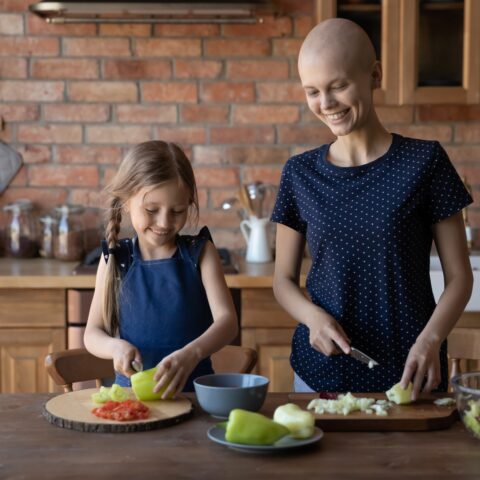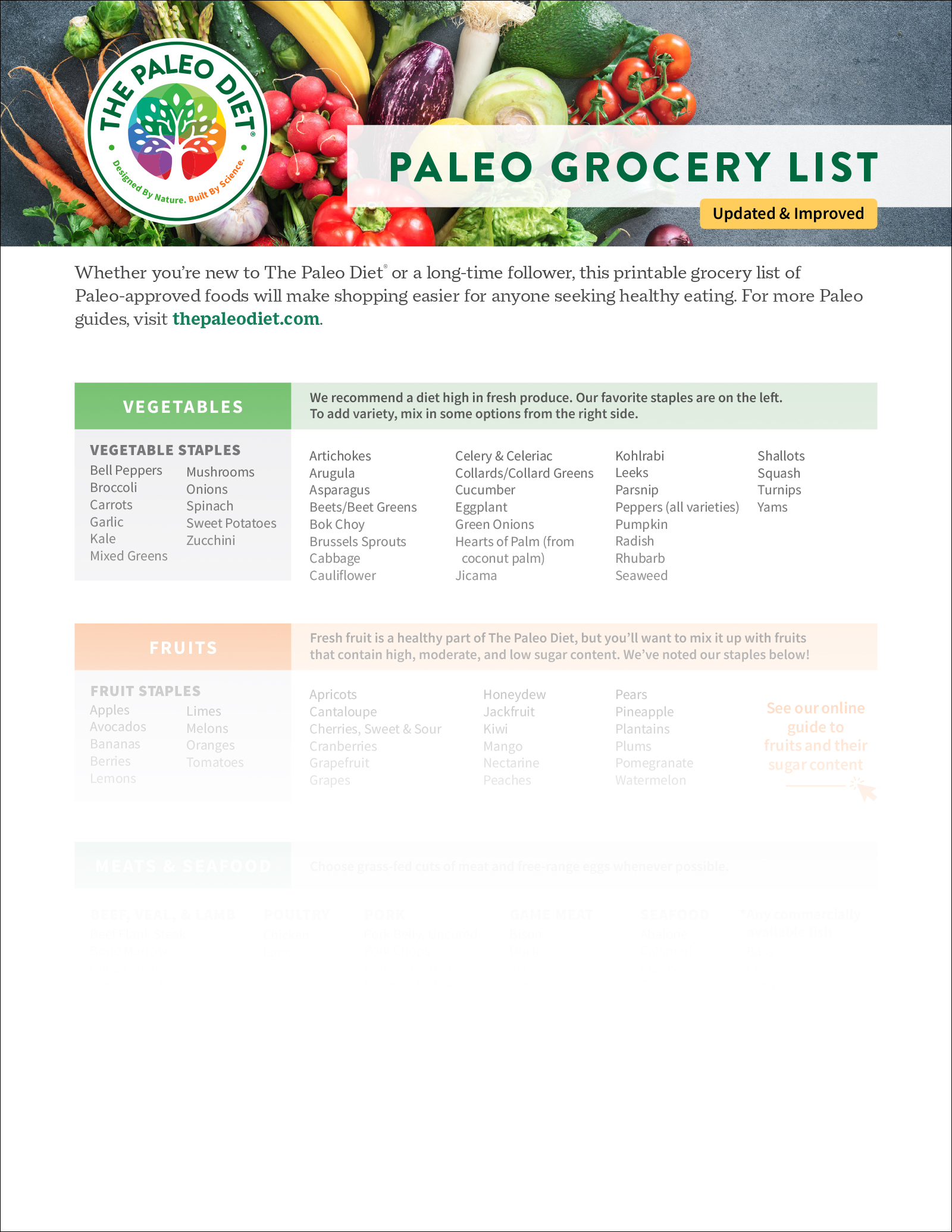Paleo-Friendly Foods That Support GLP-1 Activity

With so much media attention around semaglutide drugs, you’ve likely heard something about GLP-1 agonist medications. Glucagon-like peptide-1 (GLP-1) is a naturally occurring hormone that affects appetite and blood sugar. While millions of people are taking GLP-1 agonist drugs for diabetes and weight loss, many foods in The Paleo Diet® naturally support GLP-1 activity by triggering the release of this beneficial hormone.
How Does GLP-1 Work?
Intestinal insulinotropic hormones called incretins are responsible for regulating glucose levels. The two peptide incretin hormones involved are GLP-1 and glucose-dependent insulinotropic peptide (GIP). For the sake of this discussion, we will focus on GLP-1.1
The chemical messenger GLP-1 has four primary actions:2,3
- Stimulate insulin. When fiber, protein, and fats are digested in the small intestine and colon, GLP-1 is released and binds to pancreatic receptors. This stimulates the release of insulin and moves sugar from the blood to cells.
- Slow down stomach emptying. GLP-1 reduces the rate of food leaving the stomach by relaxing the upper stomach and tightening the pyloric tone (the muscle at the stomach’s exit).
- Influence the vagus nerve to reduce overeating. The changes in gastric motility involve the vagus nerve, a major nerve that connects the brain to the gut. Vagal nerve endings transmit signals from the gut to the brain to reduce the strength and frequency of stomach contractions, which creates a feeling of fullness, reduces appetite and cravings, and allows for better blood sugar control.
- Inhibit glucagon secretion. GLP-1 stimulates insulin release and suppresses glucagon secretion in response to food intake. Glucagon is a key hormone that helps regulate blood sugar by moving sugar from the cells to the blood, the opposite action of insulin.
How Do GLP-1 Medications Work?
As of 2024, it is estimated that as many as 12% of the U.S. population have taken a GLP-1 agonist drug.4 These medications, which mimic the functions of the naturally occurring peptide, have been in use for more than 20 years; however, they’ve gained new notoriety for their ability to help people without diabetes lose weight and change eating habits toward healthier foods. This latter observation speaks to the power of GLP-1’s connection to the vagal nerve and brain, as noted above.
As the number of users has increased by 700% in the past 12 years, the medical community is taking note of their benefits and adverse side effects.5,6 People report dramatic weight loss of 35 pounds or more; improved blood sugar management and cardiovascular health; a surprising loss of interest in sweets and salty snacks; and more interest in healthy proteins, fruits, and vegetables. Negative side effects can include muscle loss from the rapid weight loss and gastrointestinal issues, depending on the initial dosage.5,6
GLP-1 medications are currently approved for type 2 diabetes, stroke and heart attacks, chronic weight management, liver inflammation from metabolic dysfunction-associated steatohepatitis (MASH), and obstructive sleep apnea.7 A 2025 study in Nature evaluated 2.4 million people taking GLP-1 medications and identified 175 conditions with modest improvement including substance use, mild psychotic disorders, mental health outcomes, neurocognitive illnesses like dementia and Alzheimer’s disease, and seizures and lowered risk of myocardial infarction, heart failure, and stroke.8
Paleo Foods to Support GLP-1 Activity
The added popularity of these medications has raised curiosity about how to maintain healthy GLP-1 levels without drugs. The Paleo Diet is abundant in foods high in protein, fiber, and fats that support healthy GLP-1 levels and improve production of the peptide hormone, including the following whole foods.9
Beef, Pork, Fish, Chicken
Proteins from animal and fish sources provide the body with the fats and peptides necessary to support GLP-1. An interesting new finding points to the benefits of pork to stop the action of the enzyme dipeptidyl peptidase 4 (DPP-4). The GLP-1 hormone is rapidly metabolized and inactivated by DPP-4 even before the hormone has left the gut. In individuals with insulin-resistant diabetes, DPP-4 degrades GLP-1 too quickly. Pork meat proteins contain phenylalanine and tryptophan which inhibit DPP-4.10
RECIPE: Herb-Rubbed Pork Tenderloin
Eggs
Proteins and monounsaturated fats from 2-3 whole eggs for breakfast or lunch improve feelings of fullness and satiation throughout the day and supports GLP-1 secretion.11 A study found that egg-white peptides had the most effect on potent GLP-1, while egg proteins from yolks only have a modest impact.12
Fruits and Vegetables
Fermentable fibers in fruits and vegetables like pectin and inulin are fermented by beneficial gut bacteria in the colon that support GLP-1.11 Apples, berries, bananas, avocados, and raspberries contain pectins. Inulin, a prebiotic fiber, is in bananas, asparagus, leeks, onions, garlic, Jerusalem artichokes, and chicory root.
RECIPE: Fruit Salad with Poppy Seed Dressing
Nuts and Avocado
Foods like nuts and avocados are rich in monosaccharides, peptides, and amino acids, monounsaturated, polyunsaturated, and short-chain fatty acids that support GLP-1 activity.4
RECIPE: Brain-Boosting Blueberry Smoothie
Olive Oil
When compared to butter, olive oil induced higher GLP-1 concentrations, which the researchers said may indicate a relationship between fatty acid composition and incretin responses.13
Turmeric
Turmeric can increase plasma GLP-1 concentration, but the spicier the better. When twenty men consumed white rice and vegetables with three different doses of curry, the spicier meal with more turmeric resulted in higher GLP-1 than the milder versions.14
RECIPE: Gut-Boosting Sweet Potato Turmeric Soup
Green Vegetables and Plants
Spinach, kale, Swiss chard, collard greens, parsley, dill, and some types of seaweed contain a compound called thylakoids, the protein membrane essential for photosynthesis. Thykaloids raise the levels of a satiety hormone cholecystokinin (CCK) and increase GLP-1.15
A series of human studies from 2013-2015 showed that when overweight women consumed 3.5 ounces of a green drink with thylakoids before breakfast, they had higher GLP-1 levels, reduced weight, regulated blood sugar, attenuation of inflammation and fewer cravings for sweets.15-17 The researchers also noted a higher level of beneficial bacteria such as Lactobacillus reuteri.
The Caveat of Eating to Increase GLP-1 Activity
The primary difference between medications and foods that support GLP-1 activity is duration. Medications have a GLP-1 half-life of a few hours to five days, while the effect from food, when eaten slowly and mindfully, is about 30 minutes (it’s only five minutes when you eat too fast).
Researchers are studying why naturally induced GLP-1 responses from foods eaten mindfully are effective for most people and do not need to be in high amounts like the drugs.18 The best advice is to slowly eat foods rich in fiber, proteins, and healthy fats to maintain a healthy GLP-1 response.
How Exercise Affects GLP-1 Activity
The effects of exercise to improve impaired glucose tolerance and type 2 diabetes are well known, though how exercise training affects the secretory capacity for GLP-1 has been less studied. To date, the results are controversial; no evidence exists that exercise affects the half-life of GLP-1. However, exercise does impact GLP-1 levels, but how it affects healthy versus glucose tolerance-compromised individuals is still under investigation.
A 2022 meta-analysis of healthy individuals found that levels of GLP-1 could be affected by short-term and long-term training with different modes and intensities.19 For instance, the most effective short-term training was 55-65% max heart rate (HR), and the long-term training was 65–85% max HR.
Another 2022 human clinical trial examined the effect of endurance training on both beta-cell sensitivity to GLP-1 and the incretin response to oral glucose in obese normoglycemic individuals.20 Beta-cell sensitivity to GLP-1 refers to how effectively pancreatic beta cells respond to GLP-1. After 10 weeks of endurance training in obese women, beta-cell sensitivity to GLP-1 improved. However, the researchers say the effects were mild, and researchers suggest more extensive trials.
References
- Baggio LL, Drucker DJ. Biology of incretins: GLP-1 and GIP. Gastroenterology. 2007;132(6):2131-2157. doi:10.1053/j.gastro.2007.03.054
- Holst JJ. The physiology of glucagon-like peptide 1. Physiol Rev. 2007;87(4):1409-1439. doi:10.1152/physrev.00034.2006
- Sandoval DA, D’Alessio DA. Physiology of proglucagon peptides: role of glucagon and GLP-1 in health and disease. Physiol Rev. 2015;95(2):513-548. doi:10.1152/physrev.00013.2014
- Poll: Roughly 12% of US Adults Have Used a GLP-1 Drug, Even If Unaffordable. JAMA Network. June 27, 2024. https://jamanetwork.com/journals/jama/article-abstract/2819949
- Harvard Health Publishing. GLP-1 diabetes and weight-loss drug side effects: “Ozempic face” and more. Feb. 5, 2024. Accessed Mar. 19, 2025. https://www.health.harvard.edu/staying-healthy/glp-1-diabetes-and-weight-loss-drug-side-effects-ozempic-face-and-more
- Kushner RF, Ryan DH, Deanfield J, et al. Safety profile of semaglutide versus placebo in the SELECT study: a randomized controlled trial. Obesity (Silver Spring). 2025;33(3):452-462. doi:10.1002/oby.24222
- Latif W, Lambrinos KJ, Patel P, et al. Compare and Contrast the Glucagon-Like Peptide-1 Receptor Agonists (GLP1RAs) [Updated 2024 Feb 25]. In: StatPearls [Internet]. Treasure Island (FL): StatPearls Publishing; 2025 Jan. https://www.ncbi.nlm.nih.gov/books/NBK572151/
- Xie Y, Choi T, Al-Aly Z. Mapping the effectiveness and risks of GLP-1 receptor agonists. Nat Med. 2025 Mar;31(3):951-962. doi: 10.1038/s41591-024-03412-w. Epub 2025 Jan 20. Erratum in: Nat Med. 2025 Mar;31(3):1038. doi: 10.1038/s41591-025-03542-9. PMID: 39833406. https://pubmed.ncbi.nlm.nih.gov/39833406/
- Karhunen LJ, Juvonen KR, Huotari A, Purhonen AK, Herzig KH. Effect of protein, fat, carbohydrate, and fiber on gastrointestinal peptide release in humans. Regul Pept. 2008;149(1-3):70-78. doi:10.1016/j.regpep.2007.10.008
- Kęska P, Stadnik J, Bąk O, Borowski P. Meat Proteins as Dipeptidyl Peptidase IV Inhibitors and Glucose Uptake Stimulating Peptides for the Management of a Type 2 Diabetes Mellitus In Silico Study. Nutrients. 2019;11(10):2537. Published 2019 Oct 21. doi:10.3390/nu11102537
- Bodnaruc AM, Prud’homme D, Blanchet R, Giroux I. Nutritional modulation of endogenous glucagon-like peptide-1 secretion: a review. Nutr Metab (Lond). 2016;13:92. Published 2016 Dec 9. doi:10.1186/s12986-016-0153-3
- Santos-Hernández M, Amigo L, Recio I. Induction of CCK and GLP-1 release in enteroendocrine cells by egg white peptides generated during gastrointestinal digestion. Food Chem. Published online May 30, 2020. doi:10.1016/j.foodchem.2020.127188
- Thomsen C, Storm H, Holst JJ, Hermansen K. Differential effects of saturated and monounsaturated fats on postprandial lipemia and glucagon-like peptide 1 response in patients with type 2 diabetes. Am J Clin Nutr. 2003;77(3):605-611. doi:10.1093/ajcn/77.3.605
- Haldar S, Chia SC, Henry CJ. Polyphenol-rich curry made with mixed spices and vegetables increases postprandial plasma GLP-1 concentration in a dose-dependent manner. Eur J Clin Nutr. 2018;72(2):297-300. doi:10.1038/s41430-017-0069-7
- Stenblom EL, Montelius C, Östbring K, et al. Supplementation by thylakoids to a high carbohydrate meal decreases feelings of hunger, elevates CCK levels, and prevents postprandial hypoglycemia in overweight women. Appetite. 2013;68:118-123. doi:10.1016/j.appet.2013.04.022
- Stenblom EL, Egecioglu E, Landin-Olsson M, Erlanson-Albertsson C. Consumption of thylakoid-rich spinach extract reduces hunger, increases satiety, and reduces cravings for palatable food in overweight women. Appetite. 2015;91:209-219. https://www.sciencedirect.com/science/article/pii/S019566631500197X
- Foshati S, Ekramzadeh M. Thylakoids: A Novel Food-Derived Supplement for Obesity – A Mini-Review. Int J Vitam Nutr Res. 2020;90(1-2):169-178. doi:10.1024/0300-9831/a000556
- Mason AE, Saslow L, Moran PJ, et al. Examining the Effects of Mindful Eating Training on Adherence to a Carbohydrate-Restricted Diet in Patients With Type 2 Diabetes (the DELISH Study): Protocol for a Randomized Controlled Trial [published correction appears in JMIR Res Protoc. 2020 Jan 13;9(1):e17226. doi: 10.2196/17226.]. JMIR Res Protoc. 2019;8(2):e11002. Published 2019 Feb 20. doi:10.2196/11002
- Nejati, R., Bijeh, N., Rad, M.M. et al. The impact of different modes of exercise training on GLP-1: a systematic review and meta-analysis research. Int J Diabetes Dev Ctries 42, 40–48 (2022). https://doi.org/10.1007/s13410-021-00950-8
- Åkerström T, Stolpe MN, Widmer R, et al. Endurance Training Improves GLP-1 Sensitivity and Glucose Tolerance in Overweight Women. J Endocr Soc. 2022;6(9):bvac111. Published 2022 Jul 26. https://pubmed.ncbi.nlm.nih.gov/35935071/
Kimberly Lord Stewart
Kimberly Lord Stewart is an author, journalist, and culinary expert. Her work highlights the importance of incorporating whole foods into daily diets and emphasizes the connection between food and overall well-being.
More About The Author




